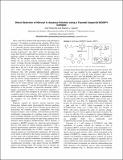Direct Detection of Nitroxyl in Aqueous Solution using a Tripodal Copper(II) BODIPY Complex
Author(s)
Rosenthal, Joel; Lippard, Stephen J.
DownloadRosenthal and Lippard JACS.pdf (745.4Kb)
PUBLISHER_POLICY
Publisher Policy
Article is made available in accordance with the publisher's policy and may be subject to US copyright law. Please refer to the publisher's site for terms of use.
Terms of use
Metadata
Show full item recordAbstract
Nitric oxide (NO) mediates both physiological and pathological
processes.1,2 In addition to cardiovascular signaling, NO has been
invoked to play a neurochemical role in learning and memory, and
it is a powerful necrotic agent wielded by macrophages of the
immune system. Whereas considerable effort has been invested to
develop metal-based3-5 and other6,7 probes for detecting nitric
oxide, there has been significantly less progress in the synthesis of
platforms capable of detecting other reactive nitrogen species
(RNS).8 Of the nitrogen oxides relevant to biology, nitroxyl
(HNO), the one electron reduced, protonated analog of nitric
oxide,9 is among the least thoroughly investigated.10 Interest in
nitroxyl has grown with the accumulation of evidence that HNO,
which has a pKa of 11.4 and exists primarily in the protonated
form under physiological conditions,9 displays important
biological roles with potential pharmacological applications
distinct from those of nitric oxide.11-13 For example, HNO reacts
directly with thiols,14 is resistant to scavenging by superoxide,15
and can activate voltage-dependent K+ channels in mammalian
vascular systems.16,17 Moreover, biochemical studies suggest that
HNO can be formed directly from nitric oxide synthase under
appropriate conditions10,18 and that NO and HNO may be able to
interconvert in the presence of superoxide dismutase (SOD).19
Despite accumulating evidence of the biological importance of
HNO, studies have been hampered by the lack of a biologically
compatible probe for the molecule. Only recently have chemical
systems capable of discerning HNO from NO been reported, but
the constructs are not suitable for work with biological
samples.
Date issued
2009-10Department
Massachusetts Institute of Technology. Department of ChemistryJournal
Journal of the American Chemical Society
Publisher
American Chemical Society
Citation
Rosenthal, Joel, and Stephen J. Lippard. “Direct Detection of Nitroxyl in Aqueous Solution Using a Tripodal Copper(II) BODIPY Complex.” Journal of the American Chemical Society 132.16 (2010) : 5536-5537.
Version: Author's final manuscript
ISSN
0002-7863
1520-5126